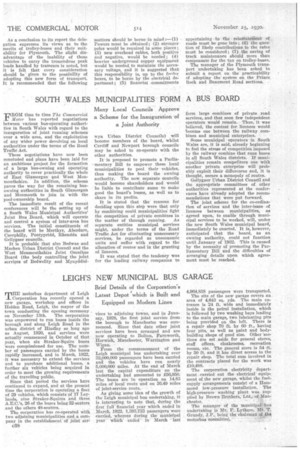SOUTH WALES MUNICIPALITIES FORM A BUS BOARD
Page 60

If you've noticed an error in this article please click here to report it so we can fix it.
Many Local Councils Approve a Scheme for the Inauguration of a Joint Authority FROM time to time The Commercial Motor has reported negotiations between various bus-operating authorities in South Wales with regard to the inauguration of joint running schemes over a wide area, and the exploitation of any wider power devolving on local authorities under the terms of the Road Traffic Act.
These negotiations have now been concluded and plans have been laid for an ambitious project for the formation of a large bus-owning and operating authority to cover practically the whole of East Glamorgan and West Monmouthshire. In addition, the scheme Paves the way for the remaining busowning authorities in South Glamorgan and Monmouth to join in with the pool-ownership board.
The immediate result of the recent conferences will be the setting up of a South Wales Municipal Authorities' Joint Bus Board, which will operate and control a system of inter-area bus services. The initial constituents of the board will be Merthyr, Aberdare, Caerphilly, Pontypridd, Rhondda and Gellygaer councils.
It is probable that also Bedwas and Machen Urban District Council and the West Monmouthshire Joint OmniIra Board (the body controlling the joint services of Bedwellty and Ilynyddisl wyn Urban District Councils) will become members of the board, whilst Cardiff and Newport borough councils• may be asked to co-operate with the other authorities.
It is proposed to promote a Parlia-mentary Bill to empower these local municipalities to pool their vehicles, thus making the board the owning authority. The now, separate councils would become shareholders and would be liable to contribute sums to make good the board's losses, as well as to share in its profits.
It is stated that the reasons for deciding upon this step were that only by combining could municipalities" fight the competition of private combines in the matter of through running. As separate entities municipal services might, under the terms of the Road Traffic Act for eliminating unnecessary services, be regarded as uneconomic units and suffer with regard to the allocation of routesand in the granting of licences.
It was stated that the tendency was for the leading railway companies to
form large combines of private road services? and that soon few independent operators would remain. Thus, it was believed, the contest for licences would become one between the railway combines and municipal enterprises.
• Some municipal operators in South Wales are, it is said, already beginning to feel the stress of competition imposed by the railway combine that runs buses in all South Wales districts. If municipalities remain competitors one with another private enterprise will probably exploit their differences and, it is thought, secure a monopoly of routes.
Gellygaer Urban District Council and the appropriate committees of other authorities represented at the conferences have already adopted the recommendations that were put forward.
The joint scheme for the co-ordination of services and the inter-issue of licences between municipalities, as agreed upon, to enable through municipal services to be worked, will, under the new South Wales municipal board, immediately be enacted. It is, however, anticipated that the board, as an owning authority, could not function until January of 1932. This is caused by the necessity of promoting the Parliamentary Bill and the difficulties of arranging details upon which agreement must be reached.












































































































